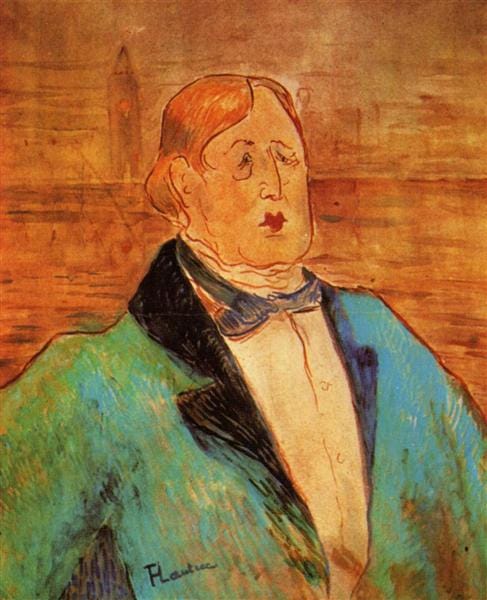Mother-Writer
October musings on the creative process (and place), Oscar Wilde's 'The Picture of Dorian Gray,' and Sonya Tolstoy
almost twelve years on and I still can't get over the ever-present tension
of deep satisfaction and nagging frustration
(cultivating the soil of little souls is exhausting)
it presses against the tender bruises
that I'd rather leave alone
wrangling the chaos of hearth and home is pure creative delight
but it never ends, never ends
I know I was made to be a mother
why does it still feel like a struggle?
every intention was made to get up with the sun
alas, the sun always wins
my whole-body energy is poured out and gone by 4 o'clock
but my fingers are itching to scratch out a thought
that has been simmering all day
I know I was made to be a writer
why can't I just sit still long enough to write?
In honor of the tension of being a mother-writer, or mother-creative of any kind, allow me to pass on a smattering of notes and thoughts on the subject(s) in easy-to-skim bullet point form (Because who has the time for a long essay? Not October, apparently.)
We inherited a new-to-us but gently loved black leather Eames lounger and ottoman from friends who were looking to get rid of it, but I’ll admit I was hesitant to add another (not small) piece of furniture to our already sufficiently furnished living room. Michael has wanted one our whole marriage, so it felt like a gift —I had to make room. And you know what? It’s like it possesses a magnet or something, I find myself settling into the deep seat and reading and writing in this spot every single day since we brought it home. Had I been denied a place, a sort of dedicated nest, until now?
Mornings are chilly, pumpkins are settled on the doorstep, and a curtain of trees surrounds our house with shades of rust and gold. I’ve just finished The Picture of Dorian Gray, by Oscar Wilde, which I chose after reading Frankenstein last fall, and wanted to continue the tradition of Gothic-themed novels for the month of October.
My impressions of the story go something like this: Lord Henry is the actual portrait of a proud, godless materialistic hedonic with too much money and too many words, and Dorian becomes his willing successor-victim. His ironic comments are constant, and a few even reference scripture and/or a Christian worldview (always with a delivery of cool intellectualism, biting snark, or zero sincerity though). People who know things say that Henry IS Wilde, which okay, I can accept that and also, he is the worst. He serves up a late nineteenth-century English upper-crust version of Jean-Ralphio and Mona Lisa Saperstein vibes (IYKYK).
The pacing is a bit slow, especially in the middle, but picks up at the end (violence will do that for a story). Without spoiling anything, it does have a nice dramatic ending - worth skimming through the detailed descriptions of tapestries and other King Solomon-level indulgences that slow down the action. Enough characters come and go that I find myself only really caring about artist and friend Basil (the only likable soul between the two covers) and Dorian.
However, what I found myself really wanting was the full story of Gray’s mother - Chapter 3 gives us a brief history of her life and it’s enough to warrant a better novel. Lord Henry makes a house visit and asks his uncle, an old nobleman, about Gray’s mother, and this is how the gentleman responds, “Of course, I knew his mother intimately…She was an extraordinarily beautiful girl, Margaret Devereux, and made all the men frantic by running away with a penniless young fellow…” As we learn, her father puts out a hit and successfully murders his son-in-law in broad daylight, and Margaret doesn’t survive the heartbreak even a year—leaving the infant boy to be raised by his miserly grandfather. If Wilde had been a woman (or maybe older, more patient) he could have given us the gift of this story, but he was too busy getting arrested for other…pursuits.
Also, check out this Henri Toulouse portrait of a middle-aged Wilde (below, dated 1895). Early in the story, poor Basil makes the assertion that, “An artist should create beautiful things, but should put nothing of his own life into them. We live in an age when men treat art as if it were meant to be a form of autobiography. We have lost the abstract sense of beauty…” Do any artists of our era (post-post-modern whatever we now call it) reject the subjective in favor of an objective beauty? The idea is so foreign, it’s almost shocking to hear it stated out loud.
Why are my favorite writers not mothers? (Mary Oliver, Annie Dillard, George Eliot, Julia Reed, and Jane Austen to name a select few…) Okay, I exaggerate, but the kind of detailed, immersive writing that I can’t help but devour seems, more often than not, to be written by women who are not mothers. It’s not entirely true because there are important exceptions (Mary Shelley and Elizabeth Gaskell, of recent mention, and Dorothy Sayers—although her one son did not live with her and was raised by a friend), but doesn’t it kind of disturb you that the really great female authors of the last two hundred years did not have families/children to care for? Is it simply a time management thing? Does the feminine urge to nurture get diverted from progeny to project? Am I the only one worrying about this?
Speaking of wives and mothers who need a fresh book written about them, Tolstoy’s wife Sonya/Sophia is on my mind lately (in no small part because of this Times book review from 1981)—she, who bore thirteen children, and loved a man of genius and difficulty—would join ol’ Leo in the library and “sit on the divan sewing quietly while her husband wrote” (via Daily Rituals, by Mason Currey), and who acted as his secretary and editor, even while confined to bed during pregnancy and severe illness. Tolstoy had a later-in-life conversion experience that radically altered his view on a myriad of things, not the least being his own profession and the money he made as a published author. I wonder, where was Sonya in this faith story? Was her frustration with his propensity to give away his profits to the poor a pragmatic response (eight surviving children to provide for, after all), or was there more to their relationship with each other, a society in turmoil, and God? It’s enough to make me actually and finally start reading War and Peace.
Artists of all kinds need both time and space to process what is happening internally - if there is any hope of an outward expression (of words on the page, paint on the canvas, clay formed into shape, etc.) there must be an inner work that proceeds it. If truth is conveyed -beauty transmitted- it can’t be rushed or slapped together in a moment of haste. I see the parallel there for the Christian; do I give the Holy Spirit the time and space to simmer over the dark waters of my heart? Or do I get impatient and try to produce something flimsy, shallow, tepid and call it “progress”? As a wife and mother, the question is not why but how…I want the work to be done, I am willing to be the vessel. But how is it done? The time, the space, the quiet (oh mothers of multiple boys and the coming cold months, let us intercede for one another), we are often lacking the essential ingredients for the creative process to happen…how?? Lord, let our meager fish and loaves be multiplied exponentially to bring you the glory you deserve.
If you have made it to the end of October musings, you deserve a treat. Coffee and tea on me the next time we see each other, okay? Stay cozy, friends.
Until next time, SBL






